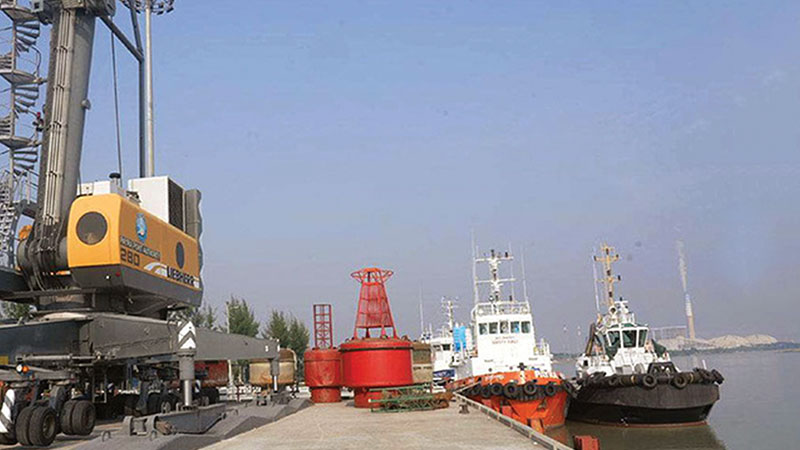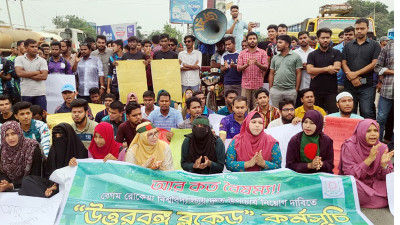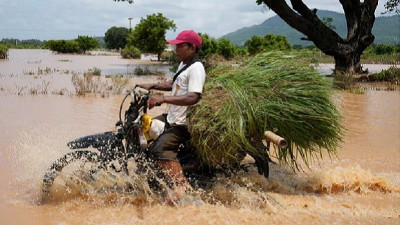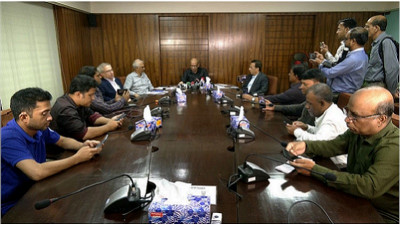 Payra Port. Photo: File/Staff Photographer
Payra Port. Photo: File/Staff Photographer The
Awami League government undertook the most expensive dredging project in the
country’s history to deepen the Rabnabad channel of Payra River in Patuakhali
through capital dredging and maintenance. The project has cost over BDT 65
billion, primarily funded by a $500 million loan from the Bangladesh
Infrastructure Development Fund (BIDF), drawn from the reserves. By March last
year, the channel’s depth had reached 10.5 meters. However, before the
project’s dredging work could be officially completed, the channel began to
silt up. The dredging work was formally completed on August 14 this year.
According to updated information as of Thursday, September 5, the depth of the
Rabnabad channel has already decreased to 7.3 meters. Experts predict that it
will drop below 7 meters by the end of the month.
Large
vessels can no longer pass through the channel, which requires a minimum depth
of 8.7 meters, according to experts. Despite the ongoing dollar shortage in the
country, they believe the entire $500 million drawn from reserves for the
dredging of the channel has been wasted.
Due
to reduced navigability, Payra port is becoming increasingly ineffective. Cargo
ships cannot dock at the port, and even the smaller vessels that can navigate
it require lighter ships for handling. Officials of the Payra Port Authority
fear that if dredging is not resumed, the channel’s depth will decrease
further. However, there is uncertainty surrounding the necessary funds for restarting
the dredging operations.
Experts
suggest that continuing dredging at the Rabnabad channel under the current
conditions would also be wasteful. Due to the channel’s location, maintaining
the desired depth is impossible. Every year, massive amounts of silt from
upstream flow into the Bay of Bengal through the Rabnabad and other Payra
channels. This silt accumulation makes it difficult to maintain the channel’s
depth. Regular dredging is required to keep the port operational, but this
process is highly costly. This has led to significant concerns among
stakeholders regarding the economic viability and future of Payra port.
A
source within the Payra Port Authority told Bonik Barta, “There is no future
for Payra port in Bangladesh. It has practically become an inland port.” Before
dredging began, a German expert team was consulted. They stated in writing that
no matter how much dredging is done, the channel will continue to accumulate
silt, and there is no alternative to continuous dredging. The feasibility study
also highlighted this issue. However, pressure from various parties at the time
forced the dredging scheme to commence.
Water
resources experts, including river and water specialist Dr. Ainun Nishat, are
also skeptical about the future of Payra port due to its geographical location.
Speaking to Bonik Barta, Dr. Nishat said, “Massive amounts of silt flow into
the Bay of Bengal through Bangladesh’s rivers. Some of it even returns to the
coast with the tides. We’ve observed that 15-20 kilometers south of the Raymangal
River, sediment is accumulating. Because the river is active year-round,
there’s no land formation, but submerged land masses are present. To keep Payra
port operational, the sediment must be cleared every three to four years to
maintain depth. The port is fine for smaller vessels. But to turn it into a
deep-sea port, regular dredging is necessary, and it’s incredibly expensive.”
According
to the Payra Port Authority, a dredging and maintenance scheme was implemented
from April 2021 to April 2024, at a cost of BDT 65.35 billion. Of that, BDT
55.5 billion was spent solely on the dredging and maintenance of the Rabnabad
channel. In March last year, the channel reached a maximum depth of 10.5
meters. After the scheme expired in April this year, emergency dredging was
carried out until August 14. Since then, all dredging activities have been
halted.
Payra
port’s dredging operations were funded through the national reserves. In 2021,
the government established the ‘Bangladesh Infrastructure Development Fund
(BIDF)’ using reserve funds. To date, this fund has only financed projects at
Payra port. When the dredging scheme for the port was initiated, Bangladesh
Bank’s records showed the gross foreign currency reserves at $48 billion.
However, as of Thursday, September 5, the latest data from Bangladesh Bank
reveals that the gross reserves have dropped to approximately $25.62 billion.
According to the international standard BPM6 method, the amount stands at
$20.55 billion.
According
to data released by the port authority, on August 14, the maximum depth of the
Rabnabad channel was 8.7 meters. Due to the cessation of dredging, silt has
gradually accumulated, reducing the depth to 7.3 meters by September 5.
Forecasts suggest it could fall further to 6.6 meters by September 25.
Typically,
a channel depth of 8.7 meters is required for a ship carrying 1,000 TEUs
containers. And vessels carrying 4,000 TEUs require a depth of 12.5 meters. The
current insufficient depth in the Rabnabad channel has disrupted ship
movements.
A
source at the Payra Port Authority informed Bonik Barta that efforts are
underway to resume dredging operations in the Rabnabad channel. The port’s
chairman has already discussed the matter with the Water Resources Adviser.
However, attempts to reach Brigadier General (Retd) Dr. M Sakhawat Hussain,
Adviser to the Ministry of Shipping, and Rear Admiral Abdullah Al Mamun
Chowdhury, Chairman of Payra Port Authority, for comments were unsuccessful.
Addressing
concerns over the channel’s declining depth, Captain S.M. Sarifur Rahman, Harbour
Master (additional duties) at Payra Port, told Bonik Barta, “Dredging was
carried out to maintain navigability under a scheme for capital and maintenance
dredging. This scheme ended in April this year. After that, emergency dredging
continued for two months, which concluded on August 14. Since then, no further
dredging has occurred, leading to silt accumulation and reduced navigability.”
He
added that the Payra Port Authority has taken the necessary steps to restart
dredging operations.
When
asked if the reduced navigability is affecting vessel movements, Rahman
responded, “Ship traffic is still manageable. In some cases, lighter ships are
being used for unloading and loading operations. However, cargo cannot proceed
directly and is being diverted to Chattogram port.”
Later,
when contacted for further clarification, Additional Secretary (Port) Mohidul
Islam of the Ministry of Shipping told Bonik Barta, “I just joined the ministry
on Thursday. I’m not yet familiar with the issue.”






